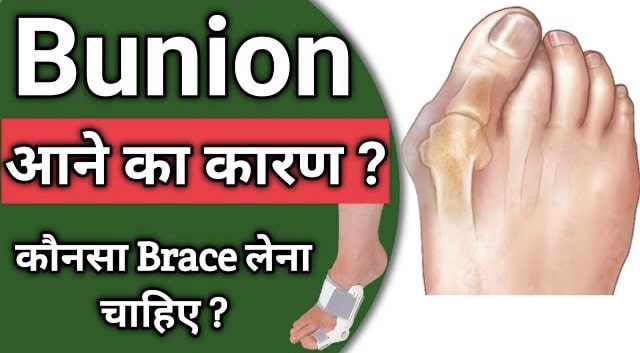Bunion and its Treatment
A bunion medically known as hallux valgus is a common foot deformity characterized by the misalignment of the big toe joint. (Bunion and its Treatment)typically appears as a bony bump on the side of the foot at the base of the big toe.
Bunions will cause pain, edema, redness and stiffness in the affected part.
The exact cause of bunions is not fully understood but they often develop due to a combination of factors
including genetics, foot structure and improper footwear.
Certain conditions such as rheumatoid arthritis can also contribute to their formation.
Over time the misalignment of the big toe joint can worsen causing the big toe to point inward and crowd the adjacent toes.
This can lead to discomfort, difficulty in finding suitable footwear and difficulties with walking or exercising.
Treatment options for bunions vary depending on the severity of the condition and the level of pain or discomfort experienced by the individual.
Non-surgical approaches may include wearing wider shoes with adequate toe space, using orthotic devices or shoe inserts, applying ice packs
taking NSAID’s and avoiding activities that worsen the symptoms.
In cases where conservative mnagement fail to provide the relief
if the bunion is causing significant pain and interfering with daily activities , surgical intervention may be require.
Bunion surgery aims to correct the alignment of the affected joint, relieve pain and improve foot function.
If you suspect you had a bunion or you are experiencing pain in your foot
it is advised to consult a QualifiedHealthcare professional who assess your conditions
such as a Physiotherapist , podiatrist who can provide an accurate diagnosis and recommend appropriate treatment options.
Bunion diagnosis
Diagnosing a bunion typically involves a combination of a physical examination and a review of your medical history.
Here are some steps that healthcare professionals may take to diagnose a bunion:
Medical history:
The doctor will ask you questions about your symptoms, when they started and any factors that may contribute to the development of bunions
such as family history or the type of footwear you typically wear.
Physical examination:
The doctor will visually inspect your foot, looking for signs of a bunion, such as a bony bump at the base of the big toe.
They will also assess the alignment of your toes and feet, check for any swelling, redness or tenderness and evaluate your foot’s range of motion.
X-rays:
In some cases, the doctor may order X-rays of your foot to get a clearer picture of the bunion and assess the degree of deformity.
X-rays can help determine the angle of the big toe joint the extent of any bone changes and the presence of arthritis.
Additional tests:
In certain situations additional tests may be recommended to rule out other potential causes of foot pain, such as blood tests or imaging studies like MRI or CT scans.
By considering your symptoms performing a physical examination and reviewing any diagnostic imaging .
healthcare professionals can typically make an accurate diagnosis of a bunion.
They will also assess the severity of the condition, which will guide the treatment approach recommended for you.
It is important to consult a healthcare professional such as a podiatrist or orthopedic specialist for an accurate diagnosis and appropriate treatment plan.
Bunion Physiotherapy Treatment
Physiotherapy can be a helpful treatment option for bunions especially in the early stages or as part of a conservative management approach.
Here are some common physiotherapy treatments that may be used for bunions:
Foot and ankle exercises:
A physiotherapist can prescribe specific exercises to strengthen the muscles in your foot and ankle, which can help improve foot alignment and stability.
These exercises may include toe curls, toe spreads, ankle strengthening exercises and range of motion exercises.
Stretching:
Stretching exercises can help improve the flexibility of the soft tissues around the bunion including the calf muscles and the plantar fascia.
This can help alleviate some of the strain on the big toe joint and surrounding structures.
Manual therapy:
Physiotherapists may use manual therapy techniques
such as joint mobilizations or soft tissue mobilization, to improve joint mobility and reduce pain.
These techniques can help address any limitations in joint movement and reduce muscle tightness or imbalances.
Orthotic devices:
Custom orthotic devices such as bunion splints or toe spacers may be recommended
To help realign the big toe and alleviate pressure on the bunion.
These devices can provide support and cushioning, and they may be used in combination with appropriate footwear.
Gait analysis and footwear advice:
A physiotherapist can assess your walking or running gait to identify any abnormalities or factors that may contribute to bunion pain.
They can provide recommendations on proper footwear, including shoe selection and modifications to reduce pressure and improve foot mechanics.
Pain management techniques:
Physiotherapists can employ various pain management techniques
such as ice or heat therapy, ultrasound or electrical stimulation, to help reduce pain and inflammation associated with bunions.
It is important to note that while physiotherapy can help manage the symptoms of bunions
it may not correct the underlying structural deformity.
In more severe cases or when conservative measures are not effective, surgical intervention may be necessary.
A physiotherapist can work in conjunction with other healthcare professionals to develop an individualized treatment plan based on the severity of your bunion and your specific needs.
